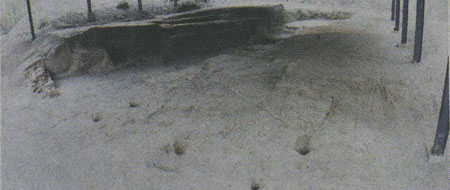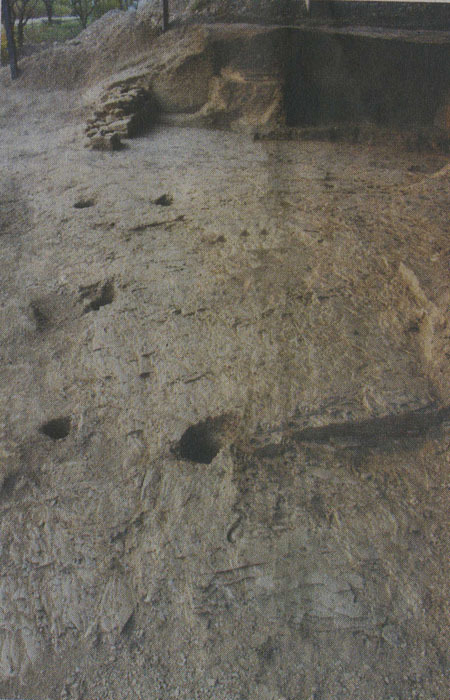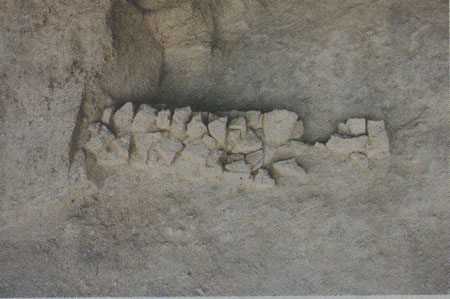A large unfinished burial of Spring and Autumn Period found at Jiwanggu, Shandong province
From:Chinese Archaeology NetWriter:Date:2014-04-11
Jiwanggu (a hill the king of Ji state ever resided in Spring and Autumn Period) is located about 40 kilometers northwest of Yishui County, Shandong province. The excavation of Tomb No. 1 (M1) and the chariot pit at Jiwanggu in 2012 became an important archaeological discovery of Zhou Dynasty in Shandong within the last few years, with great significance to the study of archaeological culture in this area.
From September to October in 2013, Shandong Provincial Institute of Cultural Relics and Archaeology in conjunction with the local cultural management department conducted an initiative excavation to Tomb No.2 (M2) at Jiwanggu, which is at the south of M1.

southern side-platform
The upper part of Tomb M2 was destroyed, and no sign of sealed-earth over mound was found. The opening of the tomb is 25.2 meters long, but the distance from north to south is unknown. The tomb is a rock shaft tomb (which was dug from mountain shale). The plane structure was divided into eastern and western parts. The west part is pit-like remains in east-west direction, and the plane is slightly trapezoidal, with pit walls inclined. And the west end of the pit bottom was irregular stair-step shaped, but the rest was flat. The pit is 14.9 meters long, and the widest point of its opening is 6.6 meters, the narrowest is 4.4 meters. There is only one layer of filling, 0.5 meters thick, which is the accumulation of shale slag. Upper part of the south wall of the pit-like remains, they all dug structures towards to the south, except the west end, and the structures were similar to the two-tiered platform. The edges were ragged, and the platform can be subdivided into three layers, with the widest point of 1.9 meters.

burial No.2
The east part is also pit-like remains, and they had already dug two two-tiered platforms at the south and the north. The plane is uneven, the distance from west to east is 10.3 meters, but that from north to south is unknown. The two-tiered platform at the north is 6.68 meters wide, and from northwest to southeast is ladder shaped tilt. The south wall of the platform is straight, because they used the natural rock crevices to dig the wall. There are five postholes dug on the stratum of the east part of the platform at the north, distributing regularly, and they are round or oval, with a diameter of 0.26 to 0.6 meters, and they are 0.38 to 0.54 meters deep. Postholes had broken the stratum deeply, speculating there might be some buildings associated with the burial. The west edge of the platform at the south roughly corresponds to that of the north one, and it is rectangular. The length of the opening is 6.4 meters, of the bottom is 5.7 meters, and the wide of the platform is 1.8 to 2.2 meters. The platform is flat, and the lowest point of this platform is lower than that at the north about 0.3 meters. The wall and bottom in the middle part of the entire eastern remains are both flat, its southern section of the east wall was built by stones, and the wall is 1.5 meters wide, 6.6 meters long, 0.4 meters tall, with about three layers left. The stones were simply processed, so both sides of wall are flat. But no stone wall was found at the northern section, and it might have been damaged later.

post-pit
The filling is mainly seen at the south of the coffin chamber, and part of the filling is hard, seems has been rammed. The upper layer is dense reddish brown soil, and it inclines from the southern part to the northern; the lower layer is yellowish brown soil, mixed with a large number of shale slag. The filling has a trend of collapsing from both the north and south sides to the middle part. Also it contains pottery shard, animal bones, conch shell, and other relics of Eastern Zhou period. Black and white ash mark can be found inside the filling, but it was irregularly distributed.

stone wall
Excavations show that Tomb M2 is a large-scale unfinished tomb. According to the burial structure, they had designed a burial pit. But no artifacts, bones or funeral objects were found, except the relics in the filling. All signs show that this tomb had not been used. Because of the messy traces of construction left everywhere in the tomb, it can be speculated this tomb was being dug at that moment, but might had been terminated by an emergency.

chiseled mark on the stone
The excavation to Tomb M2 at Jiwanggu has great significance: Firstly, as a large burial under construction, it provides precious materials for further understanding the design planning and construction craft of the Spring and Autumn Period tombs. Secondly, Tomb II provides part of the information that Tomb M1 cannot show because of damage, which has significance for fully restoring the shape and structure of Tomb M1. Thirdly, there is few historical literature recording Jiwanggu, and there is still a big debate about the country that the occupant from in Tomb M1. So the reason that behind the sudden stop of Tomb M2, which was under construction is worth pondering. We speculate that the reason might be the duke living in this region was defeated. Fourthly, as the tomb was under construction, it will open up new ideas for museums establishment. Through showing every details of the process of digging tombs, lively scenes and storyline are shaped, which will cause the audience interaction, producing unexpected good results. (Translator: Wang Jue)

